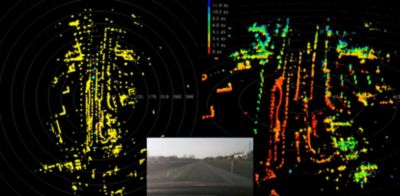-
-
学生向け無料ソフトウェアにアクセス
Ansysは次世代の技術者を支援します
学生は、世界クラスのシミュレーションソフトウェアに無料でアクセスできます。
-
今すぐAnsysに接続!
未来をデザインする
Ansysに接続して、シミュレーションが次のブレークスルーにどのように貢献できるかを確認してください。
国および地域
無料トライアル
製品およびサービス
リソースとトレーニング
当社について
Back
製品およびサービス
ANSYS BLOG
November 2, 2021
Supporting Phased Array Radar Development in Autonomous Vehicles with Ansys HFSS
As the demand for autonomous vehicle technology and advanced driver assistance systems (ADAS) continues to grow, the case for using more advanced phased array radars to guide these technologies grows. Traditional radars are robust, consistent, scalable, mass manufacturable, and potentially more cost-effective than lidar- and camera-based systems alone; however, these automotive radars have poor spatial resolution, so they tend to be blurry. They also follow a sized-performance tradeoff—the more antennas a system has, the higher the performance. Essentially, as the size and resolution increases, so does the computing power and memory that the autonomous system requires, significantly driving up application costs. This presents a significant design challenge for automakers. How do you build a cost-effective radar system that meets performance and safety objectives?

Oculii’s mission is to enable high-performance perception at a low cost on every autonomous system using radar as an appropriate complement to camera-based systems. Oculii is an artificial intelligence (AI) company that develops breakthrough technology enabling the angular resolution and performance of any phased array radar with any number of antennas by more than 100 times. This is possible thanks to their proprietary software, which dynamically adapts to and learns from the environment. Radar with this virtual aperture imaging software uses software intelligence to enhance system resolution and sensitivity, so the sensor is always improving as the software scales exponentially with more and more data. Additionally, the software runs on hardware and is fully adaptable to any platform, making it a flexible tool for both car manufacturers and original equipment manufacturers (OEMs) tasked with optimizing radar in their designs.
Although Oculii does license the software to other partners who build their own hardware, they also build full stack systems, radar modules and radar antennas to demonstrate their software capabilities and provide design references to help guide customers through their product development cycles. This guidance is a critical part of radar system development. The hardware for the radar application must be built on higher millimeter wave frequencies with a great amount of precision to allow for optimal performance. Any small tweaks and deviations in design can significantly impact system sensor performance and/or result in signal distortion.

An Oculii radar point cloud
Using Simulation to Optimize Phased Array Radar Technology
Oculii uses Ansys HFSS SBR+ simulation software to meet all of its phased array radar design challenges. HFSS allows Oculii to measure, predict and close a loop as they continue to refine their assumptions around how the design performs in the real world. Using Ansys simulation in the design phase helps Oculii design hardware with a high level of accuracy that Oculii can then implement on top of their own software as they explore new ways to optimize phased array radars for their customers in the automotive space.
“HFSS is a very powerful tool enabling us to accurately model all the different subtle variations with respect to the design as well as the materials and the manufacturing process,” says Steven Hong, CEO at Oculii. “This has given us confidence to work with our partners to design something with the outcome we can expect. We generally develop our software on top of the hardware, so we’re now building more quickly without having troubleshoot why there are issues with the hardware, even before we put our software on it.”

Steven Hong, CEO, Oculii
Finding Success with Ansys HFSS
Oculii’s main product is a 77 GHz millimeter wave automotive radar using sensors built at a very high volume at very cost-efficient price points. To come up with a viable design that can be manufactured in the millions, the yield, tolerance, and design of the hardware are all very important. Oculii looks to HFSS as a daily use tool providing the flexibility needed to analyze various aspects of antenna hardware, such as gain and loss, as well as its statistical analysis and advanced design capabilities. They also appreciate the level of knowledge, support, and commitment the HFSS team brings to their development process needed to solve some of their biggest challenges.
“The Ansys support team has been really great,” says Hong. “When we run into challenges using the tool, the team has been very helpful in terms of pointing us towards the right experts. The nice thing is that we get a different expert every time, and they all seem to be very knowledgeable about the complexities of antenna design and the capabilities of HFSS needed to solve our specific challenge. In our opinion that’s actually pretty unique.”

Oculii is an artificial intelligence (AI) company that develops breakthrough technology enabling the angular resolution and performance of any phased array radar.
Oculii is making great inroads in phased array radar development. One of the biggest wins for Oculii is their recent announcement regarding General Motors support as a major investor in their radar technologies. They’re also working with a lot of new electric vehicle companies to develop software-driven platforms requiring a combination of different sensors with a focus on electric and autonomous vehicles with unique applications in the automotive space to support a new electric vehicle (EV) class of OEM.